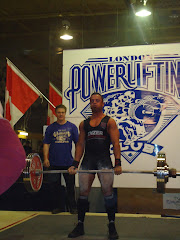
Over the 9 years I have been in the fitness industry I have found one thing to be always true: People hate squatting!
Walk into any commercial gym and you will find the squat rack either empty or being used for bent over rows, shrugs or bicep curls. Notice how it's called a SQUAT rack but no one ever squats in it? (Don't even get me started on gyms and power racks...or lack thereof). Every now and then you might see someone walk into the rack, throw some weight on and attempt a few sets of squats. I always credit someone for even attempting to squat. However, unless you have been taught to squat, you can't squat.
Sadly, the vast majority of personal trainers have NO idea how to teach someone to squat. You can't teach someone something you don't do yourself. You also can't teach something you don't understand. If you want to learn how to squat properly, contact us at Power Systems OR start by reading this book:
However, to start i will attempt to clear up any myths that I have come across in my years of training. Some are very common and some may be new to you. But all need to be set straight!
1) Myth: "Squatting below paralell will injure your knees"
Answer: I have heard this so many times and it could not be further from the truth. The only thing that will hurt your knees in a squat is to squat incorrectly. In order to squat properly and use the maximum amount of muscles, your hips should break paralell. Not only will this take the loadd OFF you knees, but it will help you build strength and mobility in your hips, hamstrings and glutes.
The knee has four main protective ligaments that keep the femur from displacing on the tibia (ACL, PCL, MCL, LCL). These four ligaments are most effective at their protection during full extension and full flexion. Full extension would be when you are standing; full flexion would be when there is no daylight between your hamstring and your calf. When the knee is at 90 degrees of flexion (the halfway point), these four ligaments are almost completely lax and cannot exert much if any of a protective force at the knee (Zatsiorsky V. Kinematics of human motion. 1998 - published by Human Kinetics - p.301).
Therefore, the worst spot for your knees is where these ligaments are under the most stress and in their least protective position, which happens to be exactly AT paralell! So make sure you are doing your knees an favor and squatting to a proper depth.
2) Myth: "I don't need to squat because I use the leg press"
Answer: Doing squats and leg presses both use the leg muscles...Thats where the similarities end. I personally feel that the leg press has its place in leg developement however it does not compare to squats on any level. If you are doing both in your program then you are on the right path. Doing only leg press is going to lead you down the wrong path.
In order of benefit, technique works its way down, not up. In other words, if you learn something difficult, anything easier will be made MUCH easier. However, if you learn something easy, no matter how good you are at it, you will never be able to do something difficult.
For example, let us take 2 lifters:
Lifter 1 can only do leg presses and Lifter 2 can only do squats. Let us say that Lifter 1 can leg press 400lbs. There is no way that he can also squat 400lbs (or even 135lbs) because squats require much more technique and utilization of motor units. But if Lifter 2 can squat 400lbs, I would bet everything I own that he can leg press alot more than 400lbs!!
3) Myth: "If I can squat really deep, I am squatting correctly."
Answer: I see this all the time. Alot of individuals attempt to squat deep and as stated previously, that's great! However, squatting really deep does not mean to are squatting correctly. Many times the lifter does not have the hip mobility to go very deep with good form so the body has to compensate by rounding the lower back, turning the ankles inward, having the knees come too far forward or cranking the wrists back. Always remember to squat with you hips, not with your knees. Here is a good assessment you can do quickly to see if your squat depth is good or bad. Stand in your normal stance and drop just like you always do. Do this for 10 reps with an empty bar on your back or using a broomstick. The important thing to note is the part of the body that first moves when you begin to squat. If it is your knees bending then we have a problem. If it is your hips pushing back then we are good to go! Always remember: Squat with your hips, not with your knees.




No comments:
Post a Comment